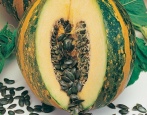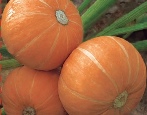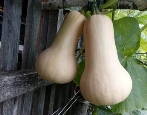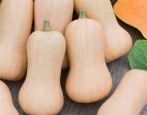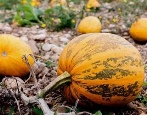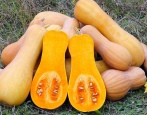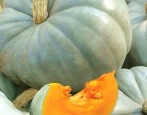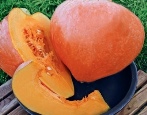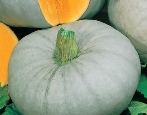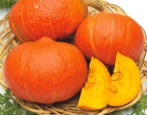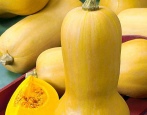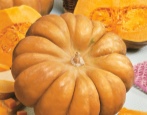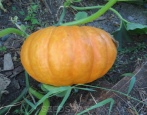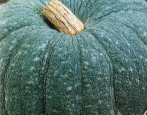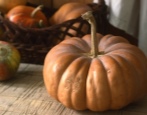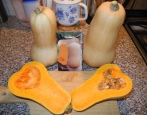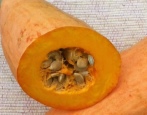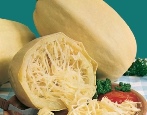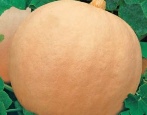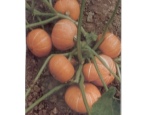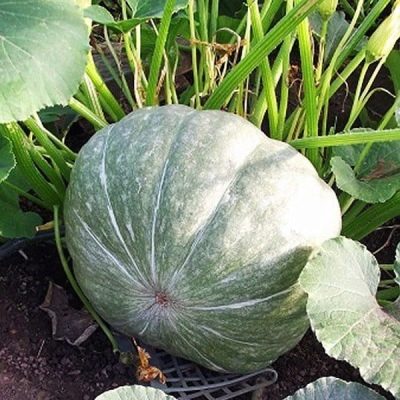
- Authors: Tekhanovich Genrikh Adamovich, Artyugina Zoya Dmitrievna, Krevchenko Leonid Elpidiforovich
- Name synonyms: cucurbita maxima 'Lechebnaya "
- Year of approval: 1994
- Growth type: medium power
- Lash length, m: short
- Leaf shape: pentagonal, non-dissected
- Leaf color: green
- The form: rounded-flattened
- Weight, kg: 3,0-5,5
- Coloration: light gray, pattern in the form of a dense mesh of dark gray color
Among the many pumpkin varieties, there is a list of varieties that are grown by most gardeners and farmers. These include the early maturing variety Healing, bred by domestic breeders.
Breeding history
Pumpkin Healing is a vivid representative of the class of melons and gourds, created by a group of scientists on the basis of the All-Russian Research Institute of Plant Growing in the Kuban. The authors of the vegetable culture are Tekhanovich G.A., Artyugina Z.D. and Krevchenko L.E. Pumpkin was introduced into the State Register of Breeding Achievements of the Russian Federation in 1994. The variety is maximally productive, growing in seven regions: Central, Volgo-Vyatka, East and West Siberian, Nizhnevolzhsky, Ural and North-West.
Description of the variety
This pumpkin variety is a compact plant with shortened whips that spread smoothly. The bush has a rather powerful growth force. The plant is characterized by moderate thickening with large pentagonal leaves of a bright green color, strong stems without grooves with pronounced roughness, a developed root system, as well as a cylindrical stalk.
This variety is bee-pollinated. During the growing season, five-petal flowers of a deep yellow color are formed on the bushes. The ovaries are formed mainly on the female inflorescences. Usually 3-4 pumpkin specimens ripen on each bush.
Characteristics of the appearance of plants and fruits
Healing pumpkin is a large-fruited species. Vegetables grow in weight from 3 to 5.5 kg. Sometimes vegetable growers manage to grow larger specimens (weighing up to 8-9 kg). The shape of the pumpkin is round-flattened. Fruit color can be different: from grayish-green with clear longitudinal white stripes to light gray, diluted with a pronounced pattern in the form of a dense dark gray net. A characteristic feature of the variety is a thick, light bloom on the surface, due to which the fruits seem slippery.
Fetal segmentation is weak. The surface of the pumpkin is smooth, thin, and the peel is easy to peel. The structure of the vegetable includes three seed cavities filled with medium-sized white seeds that can be used for planting. The harvested crop easily transfers transportation, and also has a long shelf life: pumpkins can be stored from 3 to 8 months. You can store pumpkins at room temperature.
Purpose and taste
This type of pumpkin is endowed with excellent taste. The bright orange flesh has a firm, crispy, fleshy and juicy texture without fiber or voids. The vegetable has a balanced taste: summer sweetness goes well with fruity notes and a pronounced pumpkin aroma.
A huge advantage of the variety is the beneficial composition of the pulp, which includes vitamins E, B1, B2, as well as carotene and fiber. The variety is ideal for use in baby and diet food. In addition, Healing pumpkin is widely used in cooking: it is baked, porridge, desserts, juices are prepared from it, and used as a filling for baking. It should also be borne in mind that pumpkin pulp is used in the manufacture of face and hair masks.
Ripening terms
Medicinal is an early ripening variety.From the moment of mass germination to absolute ripening of the fruits, 100-105 days pass. Due to the relatively short growing season, the pumpkin has time to ripen in a short summer. Harvesting occurs in late August or early September. The pumpkin is carefully cut along with the stalk.
Yield
The productivity of the variety is quite high. On average, about 20 kg of juicy fruits can be harvested from 1 bush. When growing a vegetable for commercial purposes, they get 36.7-42.1 t / ha.
Growing and care
Pumpkin is grown in two ways: seedling and seed, it all depends on the climatic characteristics of the region. Sowing seeds for seedlings is performed in April. They are preliminarily disinfected, treated with a growth stimulant. Planting is recommended to be done in individual cups, deepening the seed 3-5 cm into the ground. When the bushes are 30-35 days old, they can be transplanted to a permanent place of growth. A suitable period for this is considered the end of May or the beginning of June, when the soil warms up to + 12-14 degrees.
Direct seeding into the ground is recommended only in the southern regions. Sufficiently warmed soil (+ 15-16 degrees) is suitable for planting. As a rule, the pumpkin is planted at the end of May and the first half of June. The scheme of 80x80 cm is considered optimal for planting. 3 seeds are placed in each hole, deepening them in different ways. The greenhouse effect will help accelerate germination. Sprouted shoots are thinned out, leaving one plant in the hole. Good precursors for melons are potatoes, tomatoes, onions and cabbage.
The agricultural technology of pumpkin is quite simple: watering with settled warm water every 3-4 days (more abundantly watered during flowering and fruit formation), applying organic fertilizing (2 feedings until the formation of lashes, and then every 2 weeks), loosening and weeding the soil, pinching the lateral stems and central after the formation of 2-3 fruits, prevention of viruses and pest infestations. Also, do not forget about mulching, which inhibits the growth of weeds and retains moisture in the soil.
Requirements for soil and climatic conditions
Healing pumpkin is a stress-resistant culture, therefore it tolerates drought, temperature drops, nighttime cold snaps well. The pumpkin is planted in light, nutritious, breathable and well-drained soil. It is important that the soil is not acidic or waterlogged. For the cultivation of melons, the southern part of the site is chosen, where there is plenty of sun, light and heat, and there is also a barrier from drafts.
Disease and pest resistance
The pumpkin has a weak immune system, so it is important not to violate the rules of care, as well as to carry out preventive procedures: processing, spraying. The plant is often exposed to powdery mildew, fruit rot and anthracnose. Protection from attacks of pests will be provided by dusting the soil with ash.
